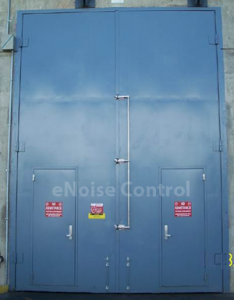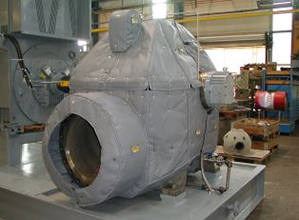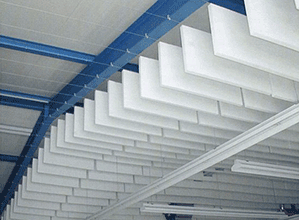Sound Control Doors: Structure and Sealing
Behind every peaceful space in a busy area is a successful soundproofing system.
Unless you live in a house in the middle of nowhere, completely merged with nature, it is likely that you are exposed to unwelcome noises on a daily basis. Noises like music blaring, children’s cries, ambulance sirens, construction noises, and traffic are common in populated areas.
Have you ever wondered how hospitals, schools, and yoga studios ensure calm, undisturbed spaces for learning and healing?
Anyone can build walls and floors using sound absorption materials. However, we still need a way to access these environments: doors.
Soundproofing doors play an essential role in enabling you to create a pleasant, restful space. In this article, we will discuss some effective features and applications for high-performing acoustic doors.
1. Door Structure
A common interior door consists of a softwood frame, extra thin wood veneers, and a hollow, air-filled core. Knocking on such doors makes a drumming sound. Based on these specifications, it is probably not surprising that they easily let any loud noise pass from one room to the next.
Here is the bottom line: the thicker the door, the better. The important thing is to choose doors that use voluminous, sound-absorbing substances. Examples of these materials are wood, fiberglass, or steel. Aside from controlling sound, these doors also provide other benefits including durability, security, and cost efficiency.
Given the variety of options for soundproof doors, it can be a daunting task to pick the right material that best solves your noise control problem. For the sake of simplicity, we will look at two representative materials that manufacturers generally use to make acoustic doors: timber and steel.
Timber Acoustic Doors
Hardwood is a great material, although it can get very expensive. Manufacturers offer a wide range of wood door options, many of which are not entirely made of wood. Most of these options have a core of foam insulation for sound control.
The natural aesthetic aspect of wood is also ideal for architectural purposes. Timber doors blend well with most surroundings, making them a popular choice among designers and architects who are involved in new building and refurbishment projects. In addition, you can get a timber acoustic door for a lower price than its steel counterpart with similar performance standards.
Despite the aesthetic benefit, wooden doors have limited performance compared to steel doors, particularly in strength and durability. In addition, many manufacturers have been able to achieve better cost efficiency with timber, leading to mass production of wooden doors. This, however, creates fewer options for custom sizes and hardware. For these reasons, if your application requires intricate specifications, you may not want to consider timber doors.
Steel Acoustic Doors
 The sleek appearance of steel has long made it a common choice for industrial applications. Over the years, manufacturers have worked on improving not only their performance, but also their look, making steel acoustic doors a more attractive option than their wooden equivalents.
The sleek appearance of steel has long made it a common choice for industrial applications. Over the years, manufacturers have worked on improving not only their performance, but also their look, making steel acoustic doors a more attractive option than their wooden equivalents.
Steel soundproof doors are perfect for highly customized, bespoke applications. With countless paint colors, steel doors welcome opportunities for creativity and imagination. With the help of new technologies and techniques, you can achieve any finish you desire, although it can get expensive.
That being said, steel acoustic doors also offer durability, strength, security, and longevity. Although they come at a high cost, they require a minimum amount of maintenance and offer great acoustic performance. Steel acoustic doors are ideal for a variety of applications such as schools, hospitals, and offices.
2. Proper Sealing
Even the most expensive acoustic door will fail to perform if you forget about the seal. The gaps around the edges and between the door and the floor can allow sound to pass through.
In fact, effective sound seals are often overshadowed by material composition and door structure. Yet they play a significant role in absorbing, insulating, and isolating sound.
Sound Transmission Class (STC) ratings are typically used to assess the effectiveness of accessories like seals. The higher the STC rating, the less sound will travel through the door and its seals.
The two main types of acoustic door seals for achieving a high-level STC rating are adhesive seals and compression seals. Depending on your specific application, it helps to recognize the benefits and limitations of each sealing type.
Adhesive seals are easy to install and are more common than compression seals. However, as adhesive seals stick into place, they offer limited adjustability once the installation is complete. If you need to modify your application in the future, these seals could prove difficult to modify. Nevertheless, adhesive seals fit standard frame designs, can be used with standard hinges, and are generally cost effective.
On the other hand, compression seals offer a higher range of STC ratings than adhesive seals. Their adaptability makes them great for accommodating special conditions. However, they require custom acoustical frames as well as a higher level of installation knowledge.
3. Making a “Sound” Decision
Aesthetic and performance are usually key factors when it comes to choosing the best door for sound control. Using an experienced and trustworthy manufacturing company can offer the best of both worlds.
This means they offer not only flexibility in design, size, and configurations, but that they also guarantee that the product lives up to acoustic performance expectations and has fast and easy-to-follow installation instructions.
When planning a sound control solution for your particular needs, it is important to understand the impact of different elements. Seek professional guidance to help you deal with difficult technical aspects and receive the right support to successfully achieve your goals.
Looking for advice from leading experts? Contact eNoise Control today to discuss your sound control door application.




